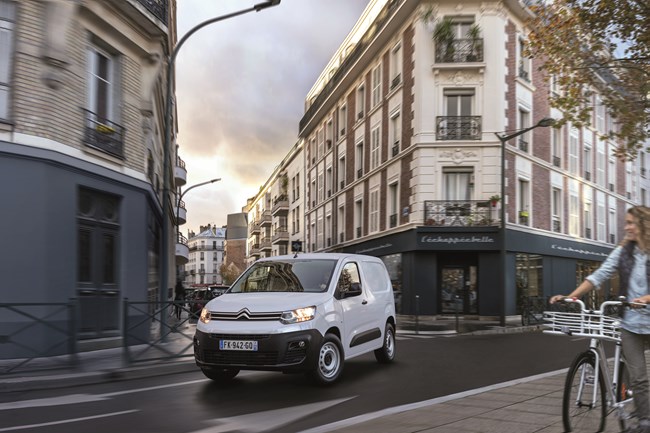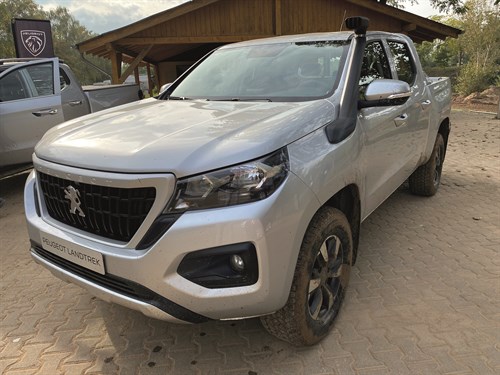- New Maxus EVs include eDeliver 5 van
- Used LCV values reach six-month high
- ADVERTISEMENT FEATURE: IVECO Daily Mission Awards 2024 Q2 Round-up: Grounds Maintenance & Forestry
- Stellantis Pro One electric vans review
- Mitie adds 5,000th EV to fleet
- Record number of CVs now on UK roads, SMMT reports
- Tyres: The path of least resistance
- ETRUX receives Ford Pro Convertor status
- The Logistics Organisation adds to van fleet with Vanaways
- Northgate launches micromobility service
IVOTY Analysis: Strength in numbers
Date: Monday, January 31, 2022 | Author: George Barrow
The new electric vans from the Stellantis group plus the Toyota versions built on the same platform are well-placed to seize the market initiative.

There’s definite safety in numbers when it comes to the Stellantis van portfolio. With Citroen, Peugeot and Vauxhall all sharing platforms for their diesel and now electric models, it looks like a pretty congested market with buyers’ only option being the badge they choose on the front of the van.
That’s not strictly true, however, as even among the latest models to hit the road, the compact electric city vans of Citroen e-Berlingo, Peugeot e-Partner and Vauxhall Combo-e, there are differences to be found. When you factor in there’s also a Toyota Proace City Electric version of the same van it’s even more important that each of the models gets its offering right.
The basics of the vans are simple. They are scaled down versions of the medium-sized Dispatch, Expert and Vivaro, with the same driveline as the electric e-Dispatch, e-Expert and Vivaro-e. The only difference is that there is just the smaller of the two batteries, so rather than a 75kWh battery there is just the 50kWh battery. That’s still good enough for a claimed range of 171 miles and paired to a 100kW motor, which in the medium-sized vans is fairly underwhelming, is blisteringly quick for a small van with a 0-62mph time of 11.7 seconds.
The similarities to the larger vans don’t end with the running gear, because the small vans also use the EMP2 platform. This is the modular platform adopted by a wide range of Citroen and Peugeot cars, and like the medium van, the small vans are made up of the front half of the EMP2 platform and combined with the rear of a commercial vehicle.
It’s a versatile chassis, which brings with it a good dose of car-like refinement. With the batteries nestled beneath the loadspace floor the handling is better than the diesel vans – improving what is already a very nicely balanced and responsive van. There’s also more grip and as a result a lot more feedback to the driver as your turn into a corner.
Like the medium vans, these small vans get two levels of regenerative braking. The standard level allows for a reasonable amount of coasting, while the enhanced braking mode button on the dash gives a stronger pullback. Using it lets you maximise the amount of energy you’re putting back in the battery but the fact that it’s dash-mounted will invariably mean that most drivers either drive with it on or off rather than bothering to reach across to activate or deactivate it as necessary. For that reason it’s nowhere near as flexible as the four-mode, steering-wheel mounted system adopted by Mercedes-Benz in the eVito and eSprinter.
The small vans do get three different driving modes, though, and just like in the larger vans they limit the amount of power and torque from the motor. Power mode provides the full 136hp with 260Nm of torque, while Eco gives just 60% of power (80hp) and 190Nm of torque. Normal mode is the middle ground with 107hp (80% power) and 210Nm of torque. The full 136hp really is quite a lot for a small van, so normal mode is probably plenty for most people’s needs, keeping the Power mode for particularly heavy loads or for when towing. Eco suits drivers looking to extend their mileage range and they will be staring intently at consumption information available through the new digital instrument panel.
The cluster has a power meter with consumption indicator, along with a battery charge level gauge. More information can be found on the 8in touchscreen display where flow diagrams of charging and regeneration can be seen along with statistics and charging schedules – the latter of which can also be controlled through new mobile apps designed for delayed charging and pre-conditioning of the cabin with air conditioning.
An already good van has been improved measurably by the process of electrifying it and lowering the centre of gravity. The small battery means charge time for the vans is very respectable and with the ability to take a 100kW charge from a rapid charging station, the small Stellantis vans can get an 80% charge in just 30 minutes. If you need to charge using a more conventional 7.4kW wall box charger then the whole battery can be charged from zero in 7.5 hours, or in just five hours with access to an 11kW three-phase supply.
Batteries and motors do mean more weight though, and that has affected the usability of the van to a small degree. With no engine and no need for a gearbox, a good amount of weight savings has been made allowing a respectable maximum payload of 800kg, with the load volume unchanged from the diesel vans. That means there’s up to 3.3m3 for standard wheelbase models and 3.9m3 for long-wheelbase vans.

Additional space can be had with the use of the fold-flat passenger seat system that incorporates a load-through bulkhead to increase the usable space to up to 3.8m3 and 4.4m3 for the standard and long vans, respectively.
That’s the common elements of the vans but the specification varies between the four brands, where each manufacturer has a slightly different target for these new electric city vans. Toyota has unquestionably headed down a premium path with the equipment on offer. Almost every option box has been ticked on the Proace City Electric and that is reflected in the price. Vauxhall has decided to cover the lower end of the market with the most basic model (although not the cheapest) providing a more fleet spec Dynamic trim option before the more well-appointed Sportive model.
Then there are the French brands, which look to be focusing on the middle ground with owner drivers and SMEs their primary target.
All vans get air conditioning and rear parking sensors along with DAB radio with Bluetooth. An 8in touchscreen appears on the e-Berlingo and e-Expert allowing Apple Car-Play and Android Auto as well as being the screen for optional rear parking cameras. It’s a well-appointed cabin that feels like it is built to a high quality with good plastics in a variety of textures. More importantly it’s a comfortable cabin to be in largely due to the very driver-focused nature of the interior. The driving position is comfortable and all the controls, including the screen, are well within reach of the driver.
The main criticism is also true of the diesel vans, and that is that the wing mirrors are definitely too small, but rearward visibility can be improved if you specify the surround view package that adds a live rear-view mirror as well as a camera covering your side blindspot, both of which are screened to a small screen in the cab in the rear mirror position.
Another point more noticeable in the electric van rather than the diesel is that there is quite a large amount of wind noise around the A-pillars. They’re minor gripes, however, and on the whole these new vans are the best in the small electric van sector. That, however, might be a short-lived statement because the new Renault Kangoo will launch in the spring with both diesel and an electric Kangoo E-Tech model – a report on which you will find in these pages in next month’s edition.
Like their medium van relatives, Stellantis’ small vans have come to market at a time when interest and appetite for electric vehicles is growing. While others have been in the marketplace longer, the evolution of the products with longer battery ranges and more powerful motors means that these vans are in a place to really capitalise. The Peugeot and Citroen models, especially, will appeal to the full range of owners, SMEs and fleets. These are the models that will push electric vans onto driveways as well as into depots.

Peugeot Landtrek
Occasionally I get to drive LCVs from far-flung lands, which is always interesting because you get to see what other markets expect and require of their commercial vehicles.
The Peugeot Landtrek is one such vehicle, built for South American, African and Far Eastern markets it was once thought that a version might find its way to Europe to allow Peugeot, or maybe Citroen, to compete in the flourishing pick-up segment.
With sales only beginning in Mexico in 2020, the Landtrek is a bit behind the curve, but after a quick drive I see no reason why it wouldn’t do well here.It’s 1.9l turbo diesel engine producing 150hp and 350Nm of torque might only meet African emissions requirements but is refined enough for our pampered posteriors and very capable with it.
A 1.0t payload, 3.0t towing capacity, 600mm wading depth and 30- and 26-degree approach and departure angles, respectively add to its ability. There’s rear diff locks, 360º surround view camera and lane departure warning amongst the options and a gutsy 210hp 2.4l petrol engine with a six-speed auto rather than the diesel’s six-speed manual. Three trim levels give it genuine global appeal and I don’t see Europe reacting any differently. Perhaps the most interesting LCV of 2021.
George Barrow is the UK judge for the International Van of the Year, the prestigious prize awarded by leading European LCV journalists.
Sponsored by:

View The WhatVan Digital Edition


